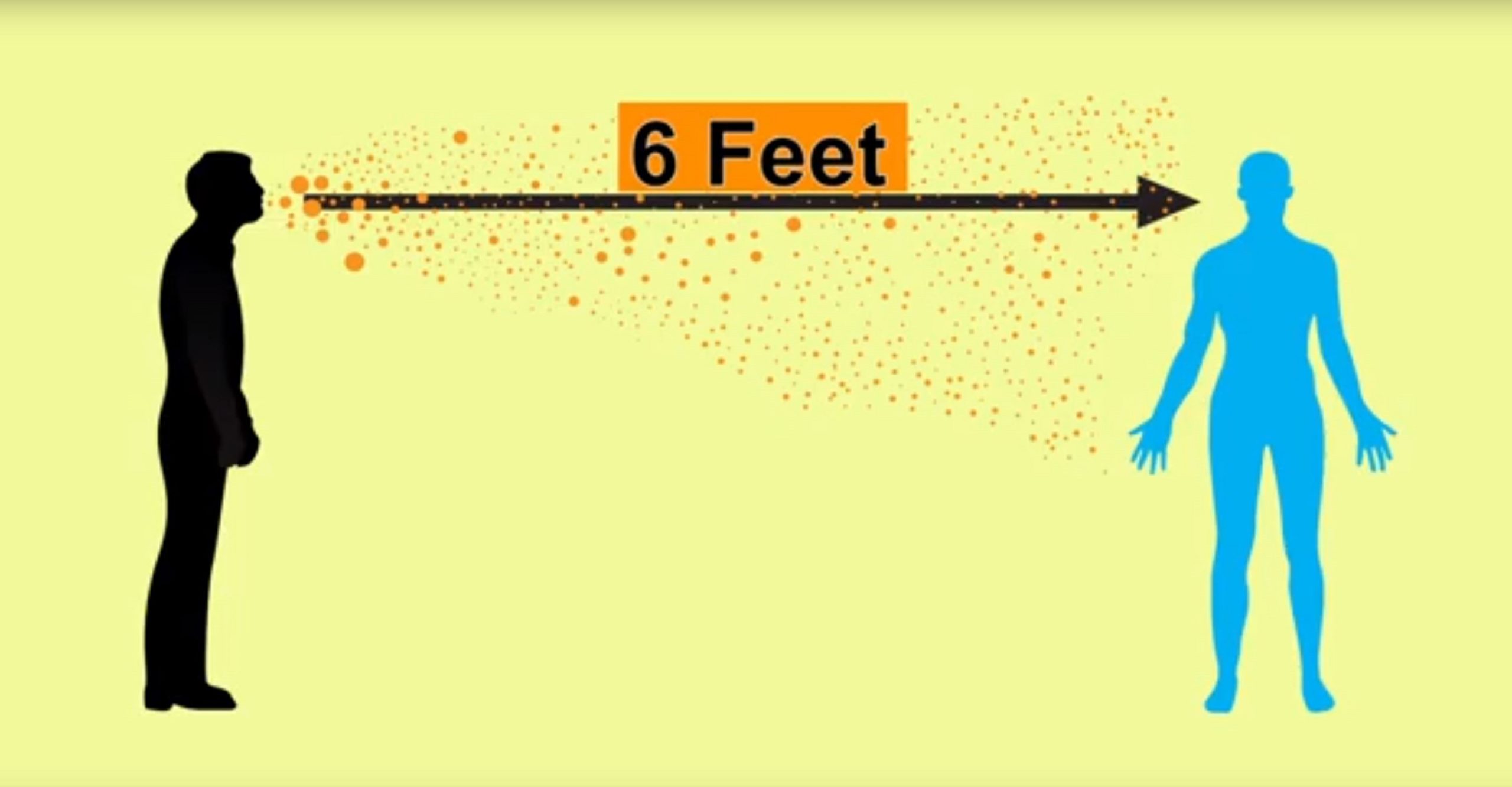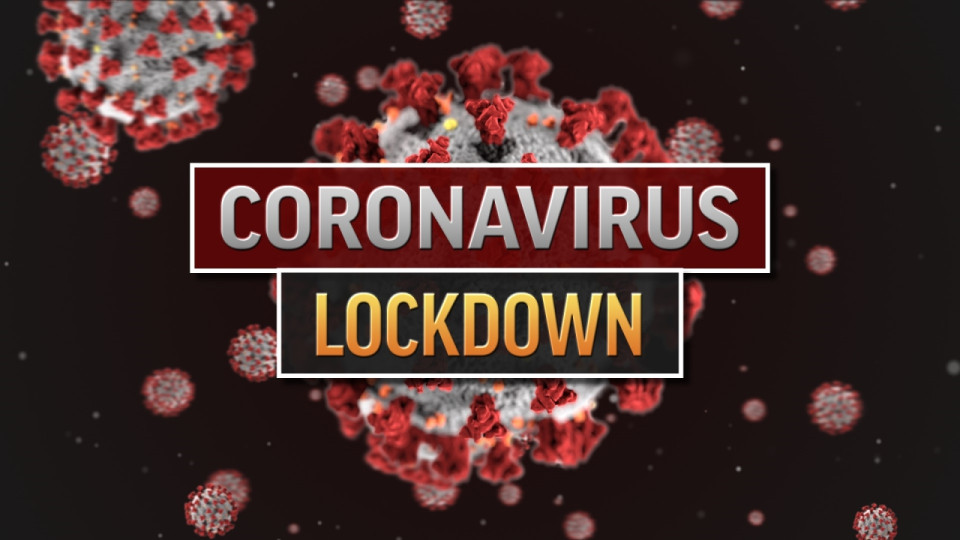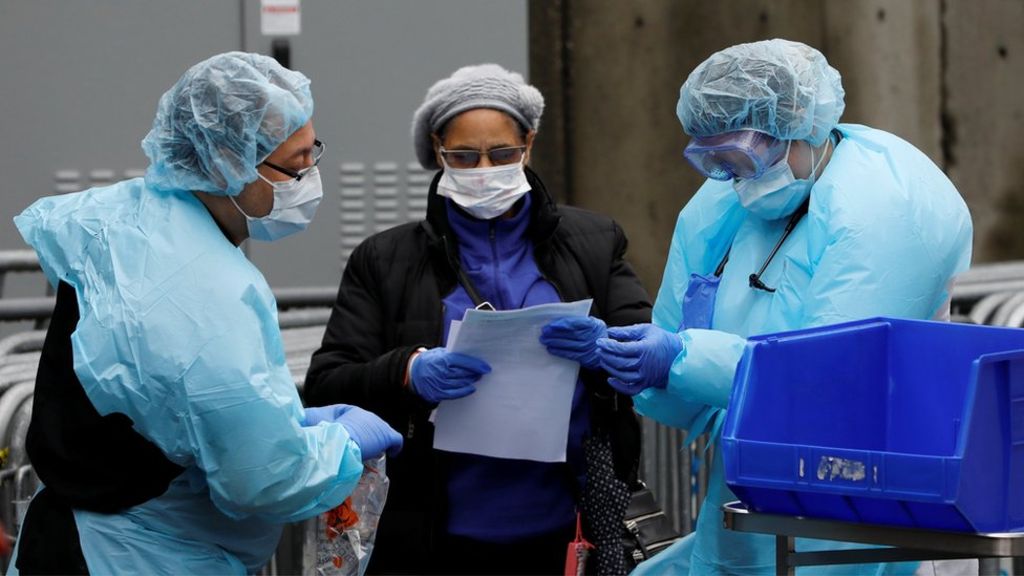
The US Senate overwhelmingly approved $484 billion in new coronavirus aid with most of the money replenishing the Paycheck Protection Program, set up to provide forgivable loans to small businesses. The bill adds another $310 billion to the Paycheck Protection Program, another $75 billion for hospitals, $25 billion for testing and $60 billion for emergency disaster loans and grants.
The bill provides no new stimulus checks for U.S. households, no additional money for food stamps, no limits on fossil fuel bailouts, no funds for election security, no bailout for the U.S. Postal Service and no additional funds for hard-hit state and local governments. Lawmakers were criticized for refusing to take up new assistance to hard-hit U.S. residents — like cash payments and food aid — in the latest relief bill. They were also criticized for not regulating the disbursement of the initial funds which allowed big businesses like corporate chain restaurants getting tens of millions of dollars in loans meant for small businesses.
They contend lawmakers are failing to provide for millions of unemployed people who are unable to pay rent and increasingly at risk of going hungry. Progressive lawmakers are demanding $2,000 monthly payments to all U.S. households and open enrollment in Medicare for uninsured and unemployed people, when lawmakers take up another round of funding, the so-called phase four coronavirus bill.
Senators are in talks for a phase four bill with priorities for that legislation including federal assistance for people having trouble paying rent, according to a Democratic source. Schumer also cited the need for funds for election reform, hazard pay for essential workers, including doctors, nurses and grocery store clerks, and funding for the U.S. Postal Service. Many are skeptical since the virus bailouts have already cost over $2 trillion, pushing our annual deficit this year to close to $4 trillion.
The pandemic continues to batter the U.S. economy as the Labor Department reported another 4.4 million U.S. workers filed for unemployment benefits over the last week, raising new jobless claims over the past five weeks to more than 26 million — a scale that hasn’t been seen since the Great Depression. As of March 13, there were already 7.1 million unemployed Americans, according to the U.S. Bureau of Labor Statistics. When the figures are combined, it would equal more than 33 million unemployed, or a unemployment rate of 20.6%—which would be the highest level since 1934.
Read more

Many Governors across the US are ending stay at home order- many of which have been in place for over a month. Reopening states to business is a difficult and controversial topic. Should states reopen too early, coronavirus cases may spike again, undoing the good social distancing did for weeks. Should they continue to stay closed, small businesses across the state may never recover and fiscal crises could severely damage many states.
Here are the states with orders set to expire:
Alaska Gov. Mike Dunleavy allowed nonessential businesses to reopen for regular business hours, with varying restrictions by sector, on April 24. Many travel and fishing restrictions have also been lifted. Alabama Gov. Brian Kemp said businesses like gyms, hair salons and barber shops could open on April 24 with theaters and restaurants reopening on April 27. Arkansas Gov. Asa Hutchinson never put an official stay-at-home order in place and has announced he hopes to ease some closures on May 4 with an announcement on when restaurants can accept dine-in customers on April 29.
Colorado’s stay-at-home order expired on April 27, moving to a new phase which allows retail businesses to do curbside pickup, other businesses can reopen with medical precautions and elective surgeries may resume. Businesses such as salons, dog groomers, personal trainers and elective medical services will be allowed to open May 1. On May 4, offices may reopen with 50% capacity.
Idaho Gov. Brad Little announced his plan to reopen the state beginning on May 1 and proceeding with four steps through June 13. The first phase would allow most retail establishments and places of worship to reopen, subject to strict social distancing guidelines. Indiana Gov. Mike Holcomb said elective surgeries may resume April 27 and he planned to lessen restrictions in early May.
Iowa has not had a stay-at-home order since April 20 and Gov. Kim Reynolds lifted the ban on nonessential surgeries beginning April 27. Kansas Gov. Laura Kelly said she is moving forward with the goal of reopening the state on May 3 if crucial guidelines are in place. Minnesota Gov. Tim Walz has projected May 4 as a reopening date.
Missouri Gov. Mike Parson is not extending the state’s stay-at-home order, set to expire on May 4. On that day, all businesses may reopen following social distancing guidelines. The mayors of Kansas City and St Louis have stay at home orders with end dates of May 15, which will supersede the state wide order and remain in effect for several counties. Montana Gov. Steve Bullock said the state’s stay-at-home order will be expire on May 3rd and certain nonessential businesses can begin to reopen beginning April 27.
Ohio’s stay-at-home order will expire May 1. Health procedures that do not require an overnight stay in the hospital may resume as well as dental and veterinary services. On May 4, manufacturing, distribution, construction and office work can resume with increased distancing and other health measures. On May 12, retail and other services may resume. Besides that, the stay-at-home order remains in place and gatherings are still limited to fewer than 10 people.
Oklahoma will lift restrictions on barber shops, nail salons, spas, elective surgeries and state parks on April 24. Movie theaters, gyms and restaurants will be allowed to reopen May 1. Pennsylvania Gov. Tom Wolf announced a phased reopening set to begin on May 8. Tennessee’s stay-at-home order would expire on April 30.
On May 1, Texas will allow retail stores, restaurants, movie theaters, malls and museums and libraries to operate at 25% capacity. However in rural counties with few cases, businesses can operate at 50% capacity. The target date for Phase 2 is May 18. Washington Gov. Jay Inslee released a plan to reopen businesses no earlier than May 4 on contingencies of a slowing of the spread of the virus.
Delaware, District of Columbia, Louisiana, Maine, Michigan, New Mexico, South Carolina, Virginia and Vermont have orders set to expire on May 15. New York will also reopen portions of the state on May 15. Connecticut’s stay at home expires on May 20. Wisconsin’s order will expire on May 26. Hawaii’s order will expire on May 30. California, New Jersey, Utah and West Virginia have no end dates to their orders.
Read more

France extended its coronavirus lockdown another four weeks until May 11. President Emmanuel Macron announced the extension in a televised address. France has reported over 140,000 cases and over 17,000 coronavirus deaths. From May 11 onward, he said, quarantine will be “gradually” lifted, starting with nurseries, K-12 schools, and some shops.
Macron’s address was his third since March 17, when the government ordered 67 million French people to stay home, allowing them out just once a day to exercise, buy food or medicine, or seek medical care. In the sobering televised address, Macron was apologetic, admitting he thought they were ready for the crisis but they clearly were not. He acknowledged state failures in rolling out testing and supporting healthcare workers, and admitted that he didn’t have all the answers. Macron said they have faced up to that and have had to make very difficult decisions that required them to adapt constantly as fragmentary information continued to change. “This moment, let’s be honest, has revealed cracks, shortages. Like every country in the world, we have lacked gloves, hand gel, we haven’t been able to give out as many masks as we wanted to our health professionals.”
France has seen progress with slowing the spread but Macron urged that that is no reason to lift the order. “I fully understand the effort I’m asking from you,” Macron told the nation, adding that the current rules were working. “When will we be able to return to a normal life? I would love to be able to answer you. But to be frank, I have to humbly tell you we don’t have definitive answers,” he said.
“Over the next four weeks, the rules must be respected,” he explained. Macron said the four-week extension will give France the ability to test anyone presenting COVID-19 symptoms, which will allow for better containment of the virus. He said that by May 11, France would be able to test every citizen presenting COVID-19 symptoms which is why the orders have to be extended.
He offered a rough timeline for how the country may reopen, starting with schools and shops in May and ending with restaurants, hotels, cafés and cinemas in July. International arrivals from non-European countries will remain prohibited until further notice. “We’ll end up winning,” Macron said. “But we’ll need to live with the virus for a few months.”
After a steady increase in cases until the first week of April, the number of patients in French hospitals’ intensive care units has started to decline, prompting health authorities to call a plateau in the epidemic. French hospitals are just about coping, while nursing homes are still overwhelmed. Some of that pressure has been eased by a massive effort to transfer patients by plane, helicopter or even high-speed train from hospitals in the east and Paris to the west.
Read more

Millions of U.S. residents are now under some sort of stay-at-home order in response to the Covid 19 pandemic. There are now over 500,000 confirmed COVID-19 cases in the U.S. — more than one-quarter of the reported total cases worldwide, though the actual numbers both in the U.S. and around the world are likely much higher due to limited testing. Governors that were originally against stay-at-home orders finally succumbed last week after COVID-19 cases in their states increased rapidly.
There are still a few states that have not issued stay at home orders. Arkansas, Iowa, Nebraska, North Dakota, South Dakota, Utah and Wyoming have yet to issue any state-wide orders but they have a number of local directives suggesting residents stay indoors or have stay at home orders in place only in their harder hit counties.
For the other 95% of Americans, the states they call home slowly joined the majority to issue stay at home orders for all non-essential activities. Just as governors issued stay-at-home orders on a rolling, piecemeal basis, they have done the same on the backend, with each governor setting his or her own time frame for lifting the order. Consequently, we have end dates spanning two months, from April 15 to June 10. More than half of the states have already extended the end date of their original order and the new end date could be pushed back again as the pandemic unfolds.
Three Pacific coast states — California, Oregon and Washington — have formed an alliance called the “Western States Pact” that will reopen at the same time. They announced that they “have agreed to work together on a shared approach for reopening our economies – one that identifies clear indicators for communities to restart public life and business.” California was the first to issue its order but within 3 days, Oregon and Washington followed suit. All three states orders were issued with no set end date so their orders stay in place until further notice.
On the east coast, seven states — Connecticut, Delaware, Massachusetts, New Jersey, New York, Pennsylvania and Rhode Island — have formed the “Multi-State Council” that will also reopen at the same time. New York Governor Andrew Cuomo said the council “will come up with a framework based on science and data to gradually ease the stay at home restrictions and get our economy back up and running.” Many of these states with an end date on their original order issued extensions with new dates in May.
Two states have stay-at-home orders that are set to expire soon; Idaho (April 15) and Kansas (April 19). Both Idaho Governor Brad Little and Kansas Governor Laura Kelly have indicated that they will extend the orders. Eight states’ orders are due to expire between April 20 and April 26. Indiana, Mississippi, Alaska, District of Columbia, Missouri, Montana, Wisconsin and Colorado are fast approaching their end dates. Four governors — half of this group — have already issued one extension and several have stated they are planning another.
For the last week of April, 19 states are due to lift their stay-at-home mandates. South Carolina, New York, North Carolina, Alabama, Arizona, Florida, Georgia, Hawaii, Illinois, Louisiana, Maine, Michigan, Nevada, New Mexico, Pennsylvania, Tennessee and Texas have end dates at the end of April but again, more than half of the governors in this group have already extended the end dates for their orders once.
Nine states have stay-at-home orders that end May 4 or later. Notably, seven of them have already bumped back their end dates once, from April to May. If the trend continues, we can expect more states to be extending their mandates into May.
Read more

In New York City, the epicenter of the US crisis, the death toll from COVID-19 is over 4,500 and continuing to climb. There have been more than 140,000 confirmed cases of the coronavirus discovered in New York, including more than 76,876 in New York City. Thirty-five percent of the confirmed cases in the US are in the state of New York. Governor Andrew Cuomo warned state residents to expect a high death rate through July.
The Federal Emergency Management Agency is dispatching more than 250 ambulances and 85 refrigerated trucks to New York to serve as temporary morgues. In Central Park, an emergency field hospital began operations to treat spillover patients from nearby Mount Sinai Hospital. Mayor Bill de Blasio has repeatedly warned city hospitals are in dire need of millions of masks, hundreds of thousands of gowns and hundreds of ventilators, and are on the brink of running out of supplies.
Following complaints by health care workers about their inability to get tested for the coronavirus despite a colleague recently dying from COVID-19, the Mount Sinai hospital system in New York City will begin providing tests on Tuesday for any employee who shows symptoms of the disease. Mount Sinai will use PCR tests for anyone showing symptoms. They will also administer a serum antibody test to anyone who was symptomatic.
The Justice Department and Department of Health and Human Services announced that hundreds of thousands of masks and other pieces of medical equipment seized from a Brooklyn man have been distributed to medical workers on the front lines treating novel coronavirus patients in New York and New Jersey. According to the DOJ, the equipment seized and distributed includes roughly 192,000 N95 respirator masks, nearly 600,000 medical gloves, 130,000 surgical masks, procedure masks, N100 masks, surgical gowns, disinfectant towels, particulate filters, bottles of hand sanitizer and disinfectant spray. Prosecutors say 43-year-old Baruch Feldheim hoarded the supplies in order to take advantage of the COVID-19 crisis and was selling them to doctors and nurses at prices as much as 700% above market value.
Governor Cuomo said it’s unclear what will happen after New York hits its peak. Cases could begin dropping off or there could be more of a plateau effect, in which new cases and death rates remain flat. Cuomo said the falling rate of infection will not be met with a slackening of social-distancing measures. Schools and nonessential business will remain closed at least until April 29 and there will be higher fines for people violating social-distancing rules. The maximum fine is now $1,000.
Read more

As homebound Americans are online for work and to keep in touch with friends and family, some internet providers have lifted data caps without significant interruptions to service from the increased bandwidth. The crisis has renewed calls for the FCC to regulate the internet as a utility and for a reversal of a repeal of net neutrality protections. Many are also adhering to the FCC’s Keep Americans Connected Pledge (PDF), which asks the signees not to terminate a customer’s service for non-payment. Below are the providers and what they have pledged.
AT&T – All AT&T home Internet Wireline customers, as well as Fixed Wireless Internet customers, can use unlimited data. AT&T will continue to offer $10/mo Access from AT&T service for qualifying customers. They will also not terminate the service of any customer who can’t pay their bill, and will waive the fees associated with late payments within the next 60 days. All their public Wi-Fi hotspots will be open to everyone.
CenturyLink- CenturyLink said it has committed to waive late fees and to not terminate a residential or small business customer’s service due to financial circumstances associated with COVID-19 for the next 60 days. They are also suspending data usage limits for customers during this time period and hav committed to the FCC’s Keeping Americans Connected Pledge.
Comcast- Comcast has paused enforcement of its data caps for 60 days, giving all of its customers unlimited data for that period. (Comcast normally gives its Xfinity customers two “grace” months for every 12, allowing them to exceed their data cap without penalty.) New subscribers to Comcast’s $9.95/month Internet Essentials plan will receive two months free, and speeds were increased to 25Mbps down and 3Mbps up. Comcast is also making its Xfinity WiFi service free for everyone, regardless of whether you’re a Comcast subscriber or not.
Cox- Cox is eliminating data usage overages for the next 60 days. Customers with a 500GB or existing Unlimited plan will receive credits. They also will not terminate service for any residential or small business customers, and would open its Cox WiFi hotspot network to keep the public connected.
Cox is offering free support calls and the first month free to its low-cost Internet service, Connect2Compete. Customers on its Essential plan will see their speeds increased from 30Mbps to 50Mbps.
Charter (Spectrum)-Charter Communications’ Spectrum services does not have data caps. They will offer free Spectrum broadband and Wi-Fi for 60 days if that household has K-12 students or college students who do not already have a Spectrum broadband subscription. Charter said it will open its Wi-Fi hotspots for public use.
Mediacom Communications- Mediacom has paused monthly data allowances through May 15 across all broadband service tiers. New customers who sign up for Mediacom’s Access Internet 60 broadband service can do so for $19.99/mo for 12 months, rather than $29.99/mo. It has also made its Wi-Fi hotspot network publicly accessible, for free, for 60 days. They also will not disconnect service or assess late fees for the next 60 days to any customer who calls and informs the company that they cannot pay their bill.
Sprint- Sprint has extended its network to include T-Mobile’s network as well for the next 60 days. Sprint has also signed the Keep Americans Connected Pledge and will waive fees and not terminate services if customers are unable to pay because of the coronavirus for the next 60 days. Customers with metered data plans will now receive unlimited data for 60 days. They will also receive an additional 20GB of hotspot data for the same period.
Starry- Wireless broadband ISP Starry has made Starry Connect, a broadband program for public and affordable housing owners, free through May. Normally, the program, which provides 30Mbps symmetrical speeds, is $15/mo. Starry has also agreed to suspend cancellation of service due to nonpayment due to the coronavirus. It already does not charge additional fees or late fees. Starry’s service does not include data caps, either.
Verizon- Verizon will waive late fees and keep residential and small business customers connected if negatively impacted by the global crisis. It is also upgrading the data plan on its Verizon Innovative Learning program for Title 1 middle schools from 10GB/month to 30GB/month for the next two months and removed data caps on Verizon home Internet subscribers. They will also waive overage charges in addition to pledging to not terminate service and waive late fees.
Read more

A Manhattan judge sentenced former Hollywood producer and convicted sex offender Harvey Weinstein to 23 years in prison. His 20-year sentence for a criminal sexual act, the more serious of the two counts he was convicted of last month, is on the higher end of New York state’s guidelines. For the other count, rape in the third degree, Weinstein was sentenced to three years in prison.
After his sentencing, Weinstein was taken under armed guard and bussed from the Manhattan courthouse to the Rikers Island jail. He was later transferred to Manhattan’s Bellevue Hospital after complaining of chest pains.
Weinstein was found guilty last month of raping then-aspiring actress Jessica Mann in a hotel room in 2013 and of sexually assaulting production assistant Mimi Haley at his apartment in 2006. Meanwhile, prosecutors in Los Angeles are working to extradite Weinstein to face further charges of rape and sexual assault in California.
In a rambling statement during his sentencing hearing, Weinstein expressed remorse, defended his relationships with the women who testified against him, said he was “confused,” bragged about the charity money he raised after 9/11 and Superstorm Sandy, lamented that his children won’t speak to him and fretted about the future of the American legal system.
His statement was unexpected and, perhaps, unwise. In general, defendants like Weinstein, who plans to appeal his guilty verdict and faces other rape and sexual assault charges in Los Angeles, are advised not to speak because what they say can be used against them, according to Michelle Simpson Tuegel, an attorney who has worked in criminal defense.
Manhattan District Attorney Cyrus Vance Jr. said in a statement “We thank the survivors for their remarkable statements today and indescribable courage over the last two years. Harvey Weinstein deployed nothing less than an army of spies to keep them silent,” he added. “But they refused to be silent, and they were heard. Their words took down a predator and put him behind bars and gave hope to survivors of sexual violence all across the world.”
Read more

Powerful tornadoes ripped through Tennessee, killing at least 24 people and injuring at least 85 more in the Nashville area. Emergency crews in Putnam County, Tennessee, where 18 of the deaths occurred-combed through shattered homes and collapsed buildings, searching for victims more than 36 hours after at least two tornadoes touched down in the middle part of the state. A state of emergency was declared in Tennessee as a result of the damage.
Damage was sustained in at least four counties in the path of the storms. Officials said that one long-track tornado produced damage that peaked at EF3 strength along a 50-mile-long corridor from Nashville east to near Gordonsville. Among the victims in Putnam County are children aged 2 to 13 years old, and several of the deceased are related to each other. Four families lost multiple people. Besides the victims in Putnam County, a total of four people were killed in Wilson County, two in Davidson County, which is home to Nashville, and one in Benton County.
More than 73,000 homes and businesses were without power in four counties, the state emergency agency said. Nashville Electric said that four substations and 15 primary distribution lines were damaged. Overturned tractor-trailers blocked stretches of Interstate 24 near Antioch and Interstate 40 near Mt. Juliet after the storm. Dozens of buildings collapsed as the winds reached at least 155 mph — EF-3 tornado level — in Mount Juliet and Donelson.
The damage stretched far beyond Nashville and across several counties. Tornadoes were reported several times along a 145-mile stretch, including in the small city of Camden just after 11 p.m. CT; in Nashville after midnight; and in the Cookeville area in Putnam County shortly before 2 a.m., the National Weather Service said. The tornado touched down near Highway 70 near Baxter and traveled to just before Willow Avenue in Cookeville, Porter said. The hardest hit areas include Charleton Square, Plunk Whitson, Echo Valley, Prosperity Point, North Mcbroom Chapel, and Double Springs Utility District.
Read more

The World Health Organization is warning the number of cases of COVID-19 caused by coronavirus is approaching 100,000 worldwide, with more than 3,100 deaths due to the illness. Most of the deaths and infections have occurred in China, where health officials reported 139 new cases and 31 new deaths recently.
South Korea confirmed 438 new cases, making their total number of confirmed cases over 5,700. Italy has over 3,000 confirmed cases and more than 100 deaths have been reported. Officials have closed down schools in Italy, South Korea, Japan, France, Pakistan, Iran and elsewhere, with nearly 300 million children kept home from school worldwide.
In the United States, there are now more than 300 confirmed cases and the death toll has reached 11 — with 10 of the deaths occurring in Washington state. California recorded its first coronavirus death: an elderly man who traveled on a Princess cruise ship that departed from San Francisco and traveled to Mexico in February. Governor Gavin Newsom has ordered the ship quarantined off the coast of California and is airlifting tests for passengers and crew. Governor Newsom made the announcement as he formally declared a state of emergency across California.
The CDC issued new guidance for clinicians on screening patients for novel coronavirus and assessing their risk for infection. The agency also started shipping its coronavirus assay to labs across the U.S. and in other countries. According to the US Centers for Disease Control and Prevention, 13 states in the US have reported confirmed or presumptive positive cases of COVID-19. Washington State has the highest number of cases with 70 confirmed illnesses and 10 associated deaths. California has 60 positive cases and 1 death.
Of the confirmed cases in California, 42 of them are linked to repatriation or international travel. Cases are rising rapidly in New York, where there are 22 confirmed cases across the state with an additional 24 testing results pending, and 122 individuals under investigation. In response to the rise in cases, the US Senate passed an $8.3 billion bill to fight the outbreak. This came just a day after the bill was approved by the House of Representatives. More than $3 billion is expected to be put into research and development of treatments, vaccines, and testing.
Read more

A Bronx woman is charged with murder and robbery in an attack on another woman at an ATM in the Bronx that lead to the victim’s death 10 days later. Police say 21-year-old Reign Harvey and at least one other person turned themselves in Thursday after authorities released images of three women involved in the attack. Police are still searching for the third woman involved.
So far, Harvey is the only person being charged in the murder of 43-year-old Tamara Sinclair, who was found dead inside her apartment on February 21. On February 11, police say Sinclair was attacked by three women as she tried to use the ATM at the Bank of America near the corner of Pelham Parkway and White Plains Road.
Sinclair was in a TD Bank vestibule on White Plains Road near Pelham Parkway South on when Harney banged on the glass door, demanding Sinclair let her in. The women claimed to have lost a debit card inside but Sinclair said to the woman, ‘I don’t know you” and refused to let them in.
Rattled, she left and crossed the street to a Bank of America to use that ATM instead. The women followed her to the second bank and they argued before Harney threw Sinclair to the ground and punched her repeatedly in the face. One of the women still at large, snatched Sinclair’s cell phone, pushed her to the ground and kicked her when she tried to fight back, prosecutors said. Another of the assailants took Sinclair’s wallet, gave it to Harney to rifle through and kicked the victim down the bank vestibule steps.
When police arrived, they found Sinclair on the ground and complaining of pain to her leg, but she declined medical attention. On February 17, Sinclair went into the NYPD’s 47th Precinct to report the assault to detectives. On February 20, she went to Montefiore Medical Center complaining of head and chest pains. Doctors believed she had a fractured ankle, but she left the hospital without further testing.
According to her sister, a doctor had warned Sinclair that she had blood clots from the beating that could kill her, but she feared a big hospital bill so she went home. The next day, she was found dead in her apartment after she did end up developing a blood clot from the fractured ankle. The medical examiner will determine the cause of death.
Read more












